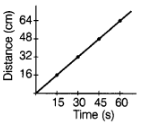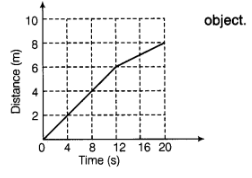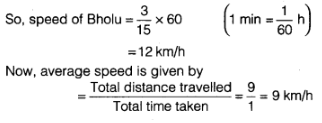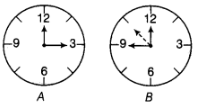Class 7 Science Chapter 9 HOTS Questions - Motion and Time
Q1: Paheli and Boojho have to cover different distances to reach their school but they take the same time to reach the school. What can you say about their speed?
Ans: They do not have equal speed because they cover unequal distance in equal intervals of time. One of them has higher speed whom has to cover larger distance with respect to other.
Q2: If Boojho covers a certain distance in one hour and Paheli covers the same distance in two hours, who travels with a higher speed?
Ans: Boojho travels with a higher speed as he has covered same distance in lesser time with respect to Paheli.
Q3: If you did not have a clock, how would you decide what time of the day is?
Ans: We can decide time of the day without a clock by seeing the shadow formed by the sun, e.g. at noon, the shadow formed by the sun is shorter than at evening.
Q4: The average age of children of class VII is 12 years and 3 months. Express this age in second.
Ans: Given, the average age of children 12 years and 3 months
1 year = 365 days = 365 × 24 h [1 day = 24 h]
= 365 × 24 × 3600 s [1 h = 3600 s]
12 years = 31536000 s × 12 = 378432000 s
3 months = 30x3days = 30 × 3 × 24h = 30 × 3 × 24 × 3600s = 7776000s
So, total age in second = 378432000 + 7776000 = 386208000s
Q5: Plot a distance-time graph of the tip of the second hand of a clock by selecting 4 points on X-axis and /-axis, respectively. The circumference of the circle traced by the second hand is 64 cm.
Ans:

As, here equal distance is covered in equal intervals of time.
So, graph will be straight line.
Q6: Given below as a figure is the distance-time graph of the motion of
(a) What will be the position of the object at 20 s?
(b) What will be the distance travelled by the object in 12 s?
(c) What is the average speed ofthe object?

Ans:
(a) From the graph, it is clear that the distance at 20 s is 8 m.
(b) Distance travelled by the body object in 12 s is 6 m.
(c) As, average speed = Total distance / Time = 8/20 = 0.4 m/s
Q7: Boojho goes to the football ground to play football. The distance-time graph of his journey from his home to the ground is given as figure.
(a) What does the graph between points B and C indicate about the motion of Boojho?
(b) Is the motion between 0 to 4 min uniform or non-uniform?
(c) What is his speed between 8 to 12 min of his journey?
Ans:
(a) Since, the graph between B and C is parallel to time - axis, so it indicates that Boojho is at rest.
(b) Since, the graph is not straight line, so it is a non-uniform motion.
(c) As, speed = Total distance / Time = 225-150/ 12 - 8 = 75/4 = 18.75 m/min
Q8: Distance between Bholu’s and Golu’s house is 9 km. Bholu has to attend Golu’s birthday party at 7 O’ clock. He started his journey from his home at 6 O’ clock on his bicycle and covered a distance of 6 km in 40 min. At that point, he met Chintu and he spoke to him for 5 min and reached Golu’s birthday party at 7 O’ clock. With what speed, did he cover the second part of the journey? Calculate-his average speed for the entire journey.
Ans: From the question, Bholu covers 3 km distance in 15 min.
Q9: Boojho walks to his school which is at a distance of 3 km from his home in 30 min. On reaching, he finds that the school is closed and comes back by a bicycle with his friend and reaches home in 20 min. His average speed in km/h is
(a) 8.3
(b) 7.2
(c) 5
(d) 3.6
Ans: (b)
Given, total distance = 3+ 3 = 6km, total time = 30 + 20 = 50 min
Q10: Which of the following cannot be used for the measurement of time?
(a) A leaking tap
(b) Simple pendulum
(c) Shadow of an object during the day
(d) Blinking of eyes
Ans: (d) Blinking of eyes
Q11: Two clocks A and B are shown in the figure. Clock A has an hour and a minute hand whereas clock B has an hour hand, minute hand as well as a second hand. Which of the following statements is correct for these clocks? (a) A time interval of 30 s can be measured by clock A.
(a) A time interval of 30 s can be measured by clock A.
(b) A time interval of 30 s cannot be measured by clock B
(c) Time interval of 5 min can be measured by both A and B
(d) Time interval of 4 min 10 s can be measured by clock A
Ans: (c) Time interval of 5 min can be measured by both A and B
|
112 videos|286 docs|28 tests
|
FAQs on Class 7 Science Chapter 9 HOTS Questions - Motion and Time
| 1. What is motion? |  |
| 2. What is time? |  |
| 3. How is motion related to time? |  |
| 4. What are the different types of motion? |  |
| 5. How does time affect motion? |  |

















